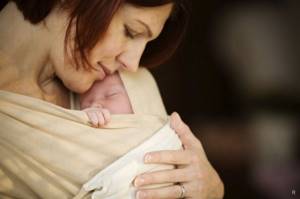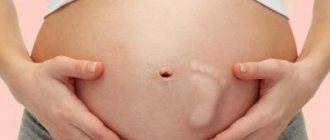Boy or girl
Traditionally, they try to guess the gender of the child by the shape of the belly. The wide and round one is a girl, and the protruding and sharper one indicates a boy. The stomach “looks” to the left towards Masha, and to the right – towards Sashka. Another interesting option for determining gender suggests that the expectant mother pay attention to the hair on her legs.
Increased hairiness - expect a boy, bare legs - expect a girl.
There is an opinion that if at the time of conception the couple is in an official marital relationship, they will have a daughter, otherwise - a son. Daily sex during pregnancy increases the chances of the baby being female, and having intermittent sex increases the chances of the baby being male. Interestingly, everything can be a decisive factor in determining the sex of a little person. For example, the future father's loose underwear
will cause the birth of a daughter, and tight-fitting clothes will cause the birth of a son.
- If you sleep with your head to the north, you will have a boy, if you sleep with your head to the south, you will have a girl.
Feeling cold in your feet
during pregnancy also indicates the birth of another man. Another, no less interesting sign: if a woman blossoms in her position, expect a hero; if she turns ugly, expect a princess. The baby’s mother always wants plant foods, and the baby wants dairy and meat.
- A swollen nose and puffy face are a sign of male gender.
On the nipples
folk wisdom also knows how to determine the sex of a child. If their color has changed to a darker side, run for pink booties; if their color has changed to a lighter side, run for blue ones.
- A girl is more likely to become the cause of toxicosis than a boy.
- But the hero provokes the appearance of hair on the stomach, and the princess - pigment spots.
An accelerated heartbeat, as well as an increased temperature, indicate that you will have a son, and a slow and lowered temperature means get ready for a daughter.
Folk signs about pregnancy - what not to do and why
If the expectant mother pricks herself while sewing or cutting food and becomes frightened, this may cause the child to develop moles.
.
Therefore, folk omens prohibit the use of a needle and knife for pregnant women. The same applies to touching your face. Touch him less often if you do not want your baby to develop birthmarks. Another belief prohibits a woman from standing on the threshold during pregnancy. Among the Slavs, it was considered the border between worlds. Staying on this border for a long time can harm the baby
.
You cannot step over brooms and logs. It was believed that this would offend the brownie, regardless of the state of health and events occurring in life. There is a separate sign regarding cats
, with which a pregnant woman is prohibited from playing.
In our time, doctors explained this superstition as the disease toxoplasmosis.
, which a pregnant woman can get from a cat.
There is a special test that detects this disease in the early stages. The expectant mother should reduce her consumption of red berries, as the baby will have “red”
skin, which is now known as
diathesis
.
To avoid the evil eye, popular rumor prohibits
a pregnant woman from telling her friends and relatives about her situation. The same applies to the name that the parents chose for the baby.
- Weaving knots can cause difficult childbirth, since the knot is considered a symbol of a dead end.
You should not sleep on your back - this makes it difficult for the fetus to breathe. The habit of sitting with your legs crossed interferes with blood circulation and can cause vein disease in the mother and crooked legs in the child.
Modern superstitions during pregnancy
It is not recommended to cut or dye your hair while you are expecting a baby. Hair is a symbol of vitality, and the shorter it is, the less it is. As for paint, it used to contain a large number of substances harmful to the baby, which cannot be said about modern products. Taking photographs during pregnancy is not recommended. This ban is explained by the fact that the photo leaves the expectant mother and her developing child static. The Church also contributed to superstitions for pregnant women, prohibiting the determination of gender by medical means and offering to trust God's will in this matter.
Towards the end of pregnancy, women, especially those preparing to become mothers for the first time, are afraid of not noticing that labor is beginning. There are a number of signs indicating this. But especially suspicious pregnant women are ready to interpret any ailment or change in the body as the beginning of labor. This is why it is so important to monitor your well-being and your baby’s behavior. This will help you prepare for an important event and arrive at the maternity hospital on time.
Content:
Signs of imminent labor in multiparous women
For women giving birth for the second time, labor goes faster because the birth canal is already ready. Doctors often advise going to the hospital in advance, since there are often cases of rapid labor that goes away in a few hours. Sometimes a woman does not have time to get to the maternity hospital to receive qualified assistance.
A girl who is pregnant again clearly and clearly feels the appearance of harbingers:
- divergence of the pelvic bones, pain when walking;
- frequent urination, urinary incontinence;
- increased blood pressure;
- cardiopalmus;
- increased fluid discharge from the vagina.
Over the course of 1-2 weeks, some changes are observed that will help you mentally prepare for the onset of labor:
- A week before giving birth, a woman’s mood and activity improve due to hormonal changes. You feel less tired, you want to finish unfinished tasks, and go to give birth with peace of mind. The period is called nesting: the woman makes repairs and rearrangements at home, prepares a dowry for the baby.
- Appetite decreases, you feel light in the stomach, and heartburn decreases. This indicates a drooping tummy.
- Training, inconsistent contractions are noticed. They prepare the body for real uterine contractions.
The birth process does not depend on what kind of child the woman has. The second time everything goes according to the well-known scenario, however, the water breaks and the interval between contractions decreases faster. A woman knows how to behave and breathe during contractions, so for many the second time turns out to be less painful and quicker. The birth canal is already ready for the fetus to pass through it, especially if not much time has passed since the first birth.
Doctors say that the interval between pregnancies should be at least 3 years. During this time, the mother’s body has time to recover and strengthen, and the muscles become toned again.
A short interval between pregnancies provokes weak labor, since not all muscles could recover. If there was a tear or episiotomy during the first birth, the scar may come apart.
Often the second birth is painful, but quick. It is also important to have chronic diseases that appear after the first birth: they must be treated.
With a long break between pregnancies, the birth canal is completely restored, so the woman gives birth as if she were a first-time mother. The birth process lasts up to 15 hours, and the pain is quite strong. In the period after 36 weeks, it is worth listening to the body to notice the appearance of precursors.
Physiological signs of close labor
As a rule, changes in the body before childbirth are associated with changes in the woman’s hormonal background, the readiness of the uterus for childbirth, the maturation of the placenta and the maturity of the fetus. Precursors of labor in a normal pregnancy appear at 38-39 weeks, but in some women they may occur earlier. Primiparas begin to notice signs of labor several days, even weeks before, while women expecting their second and subsequent babies can experience familiar symptoms in just a few hours.
"Prolapse of the abdomen"
In the old days, grandmothers predicted an early birth based on this sign. The sign is based on changes in the body that occur at the end of pregnancy. With cephalic presentation, shortly before birth, the fetal head drops lower and rises into the small pelvis, as doctors say. Accordingly, the upper part of the uterus also descends and no longer puts as much pressure on the stomach, lungs and other organs. It is not always possible to independently notice that the stomach has dropped, but the woman feels how it has become easier to breathe, shortness of breath when walking and climbing stairs ceases, and heartburn, if it has been bothering her in recent months, goes away.
When the abdomen droops before childbirth, the navel protrudes even more, and the skin on the abdomen stretches more. It is at this stage that stretch marks may rapidly appear.
Frequent urination, change in bowel habits
This is also a physiologically explainable sign. The child's drooping head puts more force on the bladder, as a result of which it cannot be filled to its full capacity, and the urge to urinate occurs much more often. The woman notices that, although she began to go to the toilet more often, the volume of urine excreted has decreased significantly.
The strong pressure of the pregnant uterus on the intestines provokes constipation. Shortly before childbirth, there is a sharp increase in the hormone oxytocin, which, on the contrary, causes loose stool. If frequent constipation suddenly gives way to diarrhea, this sign indicates an approaching birth.
Nagging pain in the lower back and lower abdomen
Before childbirth, to make the baby move more comfortably through the birth canal, the ligaments are stretched, the cartilage softens, the pelvic bones gradually move apart, which causes discomfort, and in some women quite noticeable pain. At this time, gait and posture changes. Many women also experience pain in the pubic area caused by the pressure of the fetus on the pelvic bones.
Increased discharge
White semi-liquid discharge before childbirth signals the imminent release of the mucus plug. Some pregnant women are worried that amniotic fluid is leaking. In fact, water leakage is not as common as it seems. It is observed when the rupture of the membranes occurs not at the uterine pharynx, but at one of the walls of the uterus. If you have doubts about the nature of the discharge, you should visit a doctor. Using a special test, he will determine the presence of amniotic fluid in the discharge.
Changes in the cervix
The gynecologist will tell you about changes in the cervix at your next weekly examination. The cervix shortens to 1-2 centimeters, the uterine os begins to open. It is then that doctors talk about dilation of the cervix by 1 or 2 fingers.
At this time, the membranes are located close, they are accessible to all kinds of infections, so intimate hygiene should be more careful. Toileting the genitals and changing linen twice a day is mandatory. To wash, it is not necessary to use soap every time: it dries out the mucous membrane. You can use chamomile decoction. You cannot take baths at this time; they should be replaced with a warm shower.
Removal of the mucus plug
During pregnancy, the uterine os is closed by the so-called mucous plug, which holds the baby and does not allow infection to penetrate inside. Abundant discharge in the form of a clot of mucus indicates that the plug has moved away, and the cervix will soon open. For some women, dilation occurs gradually, while for others, labor begins immediately after the plug comes out.
The plug may come out 2 weeks before birth. Sometimes the cork does not come out entirely, but in parts, so it is not always recognized. You can guess that this is it by the nature of the discharge: transparent, dense, possibly streaked with blood.
Changes in the nature of fetal movements
Many pregnant women at 38-39 weeks note a decrease in the number of fetal movements. Its movement is difficult and not so intense, since the uterus becomes crowded before childbirth.
Video: Harbingers of an approaching birth
There are also psychological precursors of childbirth associated with changes in a woman’s hormonal levels. Of course, such signs are very subjective and it can be quite difficult to draw conclusions based only on them.
Mood swings
Frequent mood swings, causeless tearfulness, and irritability are associated with an increase in the hormone oxytocin before childbirth. A couple of days after the baby is born, this mood will continue. With the restoration of the balance of hormones, the psychological state also stabilizes.
"Nesting" instinct
A few days before giving birth, a woman has an irresistible desire to prepare her apartment for the arrival of her baby. This is expressed in the fact that she takes out and puts the children's things in their places, makes the crib, irons the linen, and finds a place for the bath. In general, he arranges everything so that the child and the mother herself feel comfortable. Some women may have an irresistible desire to start renovations in their apartment and get rid of everything unnecessary.
Video: How the nesting instinct in pregnant women is explained
How children receive communion in church
The first time the baby is brought to communion is 2 weeks after the baptism ceremony. Such mothers with babies are allowed to the sacrament first. If the baby is too capricious or is tormented by gas, it is permissible not to stand in the church throughout the liturgy, but to come directly to receive the bread and wine.
Children before they turn 7 years old receive communion without going through confession, from the age of 7 - only after a conversation with a priest, so that the sacrament does not turn into a formal procedure. Wine and bread are taken on an empty stomach, so children over 3 years old should exclude breakfast, but only if the baby is completely healthy. After the child reaches the age of 7 years, you can refuse dinner on the eve of communion.
As a rule, the sacrament occurs at liturgies, so parents need to know the schedule in advance so that the baby does not suffer for a long time waiting, since it is difficult for children with their energy to stand in one place for a long time. The communion itself in the temple occurs as follows:
- The priest brings out the Cup of wine and prays over it.
- The parishioners also say the same prayer, asking the Lord to bless the wine.
- Small children are held in their arms, older ones stand near their parents.
- The priest approaches each baby in turn and says the words: “The servant of God is receiving communion (the child or godparents say the baby’s name).
- Very young children are given holy water instead of Cahors, and older children - on the tip of a teaspoon of wine.
Reliable signs of imminent labor
If before this the signs did not manifest themselves clearly, the woman was based on the words of the doctor and her own feelings and sensations, then reliable signs indicate that labor will begin in the next 24 hours:
- Uterine tone. The uterus shrinks and “turns to stone,” which can be felt well if you put your hand on your stomach. As a rule, it occurs already in the initial stages of contractions and helps the baby move towards the uterine os during childbirth.
- Contractions. The first phase, latent, is characterized by stretching of the lower abdomen. Many women confuse contractions in this phase with false ones. However, they gradually intensify, and the interval between them becomes shorter. This is already an active phase. At this time you should go to the hospital.
- Discharge of amniotic fluid. If the water breaks, this does not mean that the baby will be born immediately. Often the water breaks at the very beginning of labor, when the cervix is not yet dilated. Then doctors talk about the anhydrous period, and the woman in labor will definitely indicate how long it lasted. It happens, on the contrary, when the cervix is fully dilated, the fetal bladder remains intact. In this case, it is pierced so that the child can safely pass through the birth canal.
Important to remember:
If your water breaks outside the maternity ward, you should go there immediately. A long period without water can lead to fetal infection and birth injuries. You need to try to remember the color and smell, as well as the presence of foreign impurities (for example, blood, meconium) in the amniotic fluid and tell the doctor about everything upon arrival at the maternity hospital. Based on the nature of the amniotic fluid, he will draw a conclusion about the condition of the child.
Born in a shirt

This sign is considered one of the most famous. In Rus', a child who was born in the amniotic sac was called a real lucky one. You can still hear the expression “born in a shirt.” However, even if even a small part of the body was covered by this bubble, the child was considered protected from everything bad in the world. In all endeavors on the path of such a person, success will accompany him. For the mother, such a sign was real happiness.
Signs of premature birth
Premature births are considered to occur between 28 and 36 weeks of pregnancy. They can occur for various reasons, occurring both rapidly and gradually. Premature labor usually begins suddenly, but some signs may indicate it:
- feeling of heaviness in the lower abdomen;
- frequent finding of the uterus in good shape;
- sudden drooping of the abdomen;
- feeling of pressure on the pelvic bones;
- Increasing pain of a cramping nature.
If one or more signs of labor are detected, you should immediately consult a doctor. In most cases, premature birth can be stopped.
There is a belief that the name of a child should be kept secret until his birth. Since ancient times, it was believed that evil spirits, having learned the name of a child, would harm him and complicate his birth.
Most popular beliefs about easy, quick childbirth have a logical basis.
Signs from grandmothers
Spell for an easy birth
Women try to adhere to the signs of an easy and quick birth.
There is a sign that to relieve pain during childbirth, it is necessary to open windows and doors, cabinets, and untie knots on belts and ropes. How to clear the way for a child to enter a new world of life.
In ancient times, to relieve pain, a woman in labor was forced to chew her own braid.
You should not tell anyone that labor has begun, in order to avoid torment for the souls of everyone who finds out about the beginning of labor.
Lighting wedding candles in front of the icon, according to legend, drives away death.
To ensure a quick birth of a child, midwives sprinkled the birth canal with sugar.
Popular signs also say that a mother will love her child less if the birth is easy and quick. Although it's hard to believe it! How can a mother love her child more or less?
To relieve pain, the husband of the woman in labor should remove the shoes from her right foot and untie the belt, and the husband should also touch his wife’s back with his knee.
In order for the birth to be quick and easy, for three days after the woman is sent to the maternity hospital, nothing should be taken out of the house where she lives.
In the old days, it was believed that if you poured ice water on a woman expecting a child from around the corner, it would mean “an easy birth.”
In order to give birth without pain, a pregnant woman should bite a crust of black bread, swallow it and say: Bread, was Mother Theotokos looking at you? Did you endure physical pain during your birth? I wish I could look at it that way and not endure the pain of childbirth.
In order for the birth to go quickly, you need to throw your veil and step over it several times.
To avoid premature birth, a pregnant woman should not raise her arms high when hanging laundry.
To prevent the baby from becoming entangled in the umbilical cord, it is not recommended to knit or sew during pregnancy. What is associated with the representation of a node. It was believed that the knot tied the child out into the world. However, some pregnant women love to knit and sew and are skeptical about this sign.
A woman’s faith in charm words, signs and beliefs helps her psychologically during childbirth, and the moral support of relatives and her beloved husband guarantees a successful and easy birth.
Modern medicine's view of signs
Modern obstetricians and gynecologists, listening to such reasoning of modern expectant mothers, are quietly horrified and only agree that you should not step over obvious obstacles - for example, jumping over ditches and climbing over fences, which can provoke separation of the symphysis bones or simply lead to leg injury.
From this article you will learn:
While expecting a long-awaited baby, the expectant mother can be unusually timid and trusts everything that “experienced” women say. Should we believe in all the signs for pregnant women that we hear from so-called well-wishers, or will a small “filter” in our head not hurt us? Let's find out!
So, let's start with the fact that all folk signs and superstitions regarding pregnant women and future babies are the result of many years of observations that can be confirmed or refuted by scientific data.
Boy or girl
The most interesting signs are those indicating the gender of the unborn child.
So, for example, a woman suffering will most likely give birth to a girl, and a pregnancy that proceeds “without problems” will end with the birth of a boy.
Meat lovers are predicted to have a son, while those with a sweet tooth will rejoice at their daughter.
A sharp belly means expect an heir, and a round belly means an heiress.
If the first movement of the fetus is felt in the right side of the abdomen, a boy will be born, if in the left, a girl will be born.
Question three. Harbingers of childbirth
The first signal that labor is approaching for many expectant mothers is training contractions.
Shortly before birth, the fundus of the uterus drops and the pressure on the diaphragm decreases. Therefore, you can now breathe deeply again.
Important! If you are expecting twins (triplets, etc.) or have polyhydramnios, this “sign” may be absent.
The baby's head descends to the entrance to the pelvis and presses on the bladder. Usually this “sign” is more noticeable to those who are going to become a mother for the first time.
If frequent urges cause you discomfort, be sure to wear a bandage. It will support the abdomen from below and lift it, reducing pressure on the bladder.
Weight loss
Have you started losing weight or has your weight gain stopped? Most likely, there is very little time left to wait. The fact is that a woman’s body independently removes excess fluid from the body before giving birth. Therefore, even if a woman eats well, her weight still does not increase, or even decreases.
Throughout pregnancy, the cervix is closed by a mucous plug, which protects the embryo, and then the fetus, from external influences. But when the baby is preparing to be born, the need for it disappears, and it moves away.
At this time, the expectant mother may notice that she has a mucous discharge similar to egg white. Minor bloody spots are acceptable. The mucus plug may come off over several days.
Nagging pain
Shortly before childbirth, mild nagging pain may appear in the lower abdomen, in front, behind and/or above the tailbone. This is the effect of relaxin, a substance responsible for loosening the ligaments of the pelvic bones. Therefore, if you feel such pain, know that the body is completing its final preparations.








